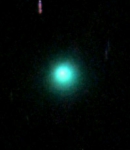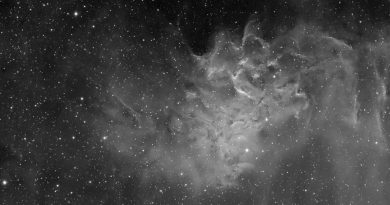Comet 2P/Encke’s Blaze of Glory
 After being photographed at the end of February, showing off 3 green tails, comet 2P/Encke prepares for the final act of this apparition: a week-long plunge through the stars of Pisces toward the western horizon and perihelion. At the end of February the comet had brightened to almost 8th magnitude. Encke’s orbit this week takes it between the earth and sun — which will cause it to reach peak brightness and then disappear from sight . Use the horizon diagrams here to help you spot it.
After being photographed at the end of February, showing off 3 green tails, comet 2P/Encke prepares for the final act of this apparition: a week-long plunge through the stars of Pisces toward the western horizon and perihelion. At the end of February the comet had brightened to almost 8th magnitude. Encke’s orbit this week takes it between the earth and sun — which will cause it to reach peak brightness and then disappear from sight . Use the horizon diagrams here to help you spot it.
Encke’s distance from the earth varies from 0.81 au on March 1st to 0.70 au on the 7th while its solar distance diminishes from 0.42 au 0.35 au.

From mid-northern latitudes, Venus will guide you to 2P Encke each evening. Encke and Venus start the month about dead west. Referring to the diagram below, on March 1st, when it gets dark, you’ll find the comet midway from the brilliant planet and the horizon. Using a low-power, wide-field eyepiece — like our Panoptic 24mm — to pick it out. Even an hour after sunset, Encke is a comfortable 8-deg above the horizon. But as shown in the diagram, the dirty snowball will get progressively lower each day and drift slightly to the south. By the end of the first week of the month, on March 7th, the comet may be too low for you when it gets completely dark. On that date, about 40-minutes after sunset, it will be only a degree above the horizon.

Observers along the equator will get a different view of Encke’s path. The daily plot shows it gliding down the horizon as it moves south away from Venus. On March 1st, at the end of nautical twilight, the comet is 6-2/3-deg above the horizon. By the 7th it’ll be below the horizon at the end of nautical twilight – so best to locate it by the end of civil twilight (20-minutes after sunset) when it is still 2-1/3-deg above the horizon.

It is worth noting Encke’s place in the history of astronomy. With a short period of only 3.3-years, Encke’s passage through the solar system has been recorded numerous times. But these classical observes had no idea that the comet they were observing was one and the same. German astronomer Johann Franz Encke analyzed past comet orbits and predicted the comets return in 1822. As the second periodic comet discovered, it carries the designation “2P” and the moniker of the person that predicted its return.
 More Info
More Info
Posted on Mike’s Astrophotography Gallery & Blog is a TV-85 image of Encke taken with a Canon DSLR. You can make out at least two tails on the negative inset of the full-size photo.




